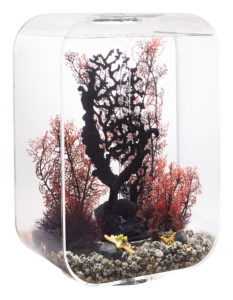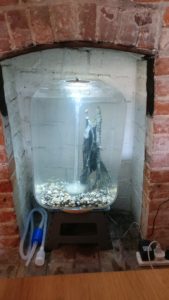Aquarium by Oase
Oase biOrb review
Oase makes some very pretty looking aquariums with an aesthetic I find appealing. They have a clean look so you see mostly what’s in the aquarium rather than the actual aquarium itself. They also come in a variety of shapes quite different from the traditional long rectangular aquarium shape (more on this in a bit). There is a rounded vertically oriented option that would seem to fit our fireplace well. The conventional wisdom is that “bigger is better” because water parameters tend to be more stable with larger water volumes. We opted for the 45 L option as a reasonable fit. The other size we considered was the next size up, 60 L, which is also the largest size on offer. 60 L would have been (W x H x D) = 42 x 62 x 28 cm. Our fireplace is not quite built square (“period style” as they say) but is roughly 60 x 90 x 35 cm. The 60 L is not dimensionally much larger than than 45 L but I was concerned that with the 60 L only having 9 cm of clearance around the sides it would be a tight fit trying to get in behind the thing for maintenance. The 45 L gives clearance of 11.5 cm. Tough call but I think we went with the best option for the space with the 45 L.
The price you pay for looks…
So, the bit about how most aquariums don’t look like this one; there are (lots of) reasons for that.

biOrb LIFE 45 MCR transparent
Volume in litres
Dimensions (W x H x D)
Colour
Bulb type (as supplied)
45
37 x 56 x 25 cm
clear
MCR LED
There is no filter
Well, there is of course. There is no external filter, nor is there an obvious “hanging down from the wall” or “cleverly built into the back behind a hidden panel” type of filter. In the biOrb setup, the main filter is the substrate on the bottom of the aquarium itself. See the large rocks on the bottom in the picture? Those are specially designed super-porous rocks to encourage an active and healthy population of beneficial micro-organisms to do most of the metabolic heavy lifting for converting toxic fish waste byproducts like ammonia into much less harmful nitrates (by way of also toxic nitrites). But how do you convince the water in the tank to circulate through these porous rocks? It’s hard to see in the picture but there is a clear acrylic hollow cylinder in the middle of the tank maybe 35 cm high by 3 cm in diameter. The cylinder connects to a plastic filter cartridge with multiple small openings hidden under the rocks and maybe 15 cm in diameter. Inside this cartridge, which is removable when lifted out by the cylinder (which can be attached/detached from the cartridge) through the top of the tank is a replaceable sponge to provide extra filtration (and more surface area for beneficial microbes) and a small compartment with some zeolite ion exchange media with some activated carbon granules to chemically remove harmful waste. The whole assembly mounts on an airstone which is fed from an air tube that mostly unseen goes around the back of the tank and up through the bottom of the tank. When you connect up to an air pump, the bubbles from the airstone rise up through the cylinder, pushing water with them and creating a water flow upwards through the cylinder, which pulls water into and through the porous rock substrate, then into the plastic filter cartridge, through the sponge, over the ion exchange media and the activated carbon, and back up through the cylinder. The water flow concept is clever (I later found out this is an example of an “air lift tube”) and works well – this is the only filter the Fireplace Aquarium has ever had, and if you don’t need to faff around with external filters, why would you?
Installed biOrb

Oase recommends changing the sponge and granules every 1-2 months…
…and will happily sell you the replacement materials. That being said however, I’ve never noticed the sponge to ever get full of particulate material – the substrate itself seems to do a reasonable job of blocking larger debris that can be removed with a gravel vac during water changes. The amount of resin/granules inside the cartridge seems ridiculously small to have any meaningful effect on chemical composition of the aquarium water. It’s also a major hassle removing the whole assembly out through the relatively small port in the top of the tank, especially inside the fireplace. After a while of half-heartedly trying to maintain some type of schedule I just gave up on the whole concept. I haven’t changed the sponge or the resin for a long time now.
The light is nice
The MCR light at the top has multicoloured LEDs that can be controlled by a remote control. There is the capability to use the remote to set some basic daily timing e.g. on for 10 hours per day. You can pick different colours of “on” light if you like. At night the light is a dim blue “moonlight” simulation.
If all you want is coldwater fish and inert decorations, you’re probably good with this setup
Summary of good and bad points for the Oase biOrb LIFE aquarium
Good List
- Looks great!
- No external filter
- Closed top keeps jumpy fish in, external debris out and CO2 levels up
- Acrylic seems reasonably resiliant for acrylic – few scratches
- Air pump is quiet
- Almost the only example of an aquarium that is taller than it is wide – supports growth of taller plants without being massive
Bad List
- Small opening at the top makes access difficult
- Lid needs surgery to allow in a heater cable and a CO2 line at the same time
- Light too weak to support much plant growth
- Algae growth on/inside bubble tube is challenging
- spot treatment with liquid carbon seems to sort this out reasonably well
- the ceramic filter media can’t support growth of plants that need soil
- you can add soil on top of the ceramics, and likely the ceramic would directly support epiphyte growth (Anubias, Bucephalandra etc.) without added soil